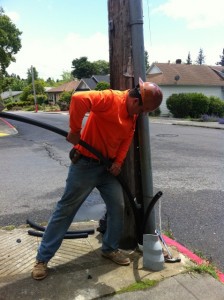
Moving Outside: From ISP to OSP
Written by Dane Jasper
July 31, 2011 | 2 min read
This month Sonic celebrates seventeen years of providing Internet access, and we celebrate a major milestone: our first step outside.
An an Internet Service Provider (ISP), beginning in 1994 with dialup Linux shell access, we used conventional phone lines from Pacific Bell and 16.8kbps modems to provide access. When “X2” 56kbps dialup arrived in 1997, these lines upgraded to digital ISDN BRI and then later large PRI lines.
Then, with the launch of DSL at 1.5Mbps in 1998, we switched to large Pacific Bell T3 ATM circuits for customer aggregation, and over the years DSL gradually evolved from 1.5Mbps up to 6.0Mbps, and from the Central Offices whice serve 60% to 80% of premises to Remote Terminals which allowed nearly everyone to obtain DSL.
The circuits got larger and larger, and our reach grew across California. In 2005 we opened our DSL aggregation network to serve other ISPs, and today there are seventy Internet Service Providers that utilize our Open DSL Network to deliver AT&T ADSL1 broadband to consumers in California and beyond.
But back then all of the Sonic.net infrastructure was ensconced in our datacenters in Santa Rosa, San Francisco, San Jose and Los Angeles. We relied upon AT&T (formerly known as SBC California, and before that Pacific Bell) to connect us to from there to the customer premise, using their ATM backhaul network and DSL Access Multiplexers (DSLAMs). It has been a good partnership for us, for them, and for our mutual customers.
In 2006 we took the next step and became a telephone company ourselves, and began to build our own “Inside Plant”, in the carrier business known as “ISP”, not to be confused with “Internet Service Provider”. Inside Plant (ISP) is the electronics in the Central Office, the DSLAMs, Ethernet aggregation and voice switching. Inside plant equipment connects to the outside plant copper loops, which are a shared resource for all telephone companies under the 1996 Telecom Act, the law which created competition in local telephone service.
This brought us from being a conventional ISP (Internet Service Provider), to a carrier ourselves, building our own “ISP” (InSide Plant), and a big step closer to customers. With the construction of this next-generation facilities-based carrier network, in 2008 we launched our enterprise FlexLink Carrier Ethernet products, and in 2010 the innovative Fusion Broadband+Phone service. This brought us out of the isolated datacenters, instead building new equipment into every telephone central office, and it has delivered fast, exciting broadband products at great prices, plus our own voice telephone services too.
Now we have taken the next step, building our first OSP: OutSide Plant. The outside plant is the part of the network which is on the poles and in the ground; the cables, splices, cabinets and terminals. And, just as we built the newest DSL and Ethernet technology into our inside plant, we are building a cutting-edge OSP network: Fiber-optic cable to every home we pass.
This has been an interesting process for me, and our amazing team over the years. While many early-days ISPs have consolidated, sold, ceased business or simply shifted away from the business of providing access, we are committed to continued innovation as an Internet Access Provider.
With our continued partnership with AT&T, plus our facilities as a CLEC, and new construction of Fiber outside plant, we are moving onward and upward.

